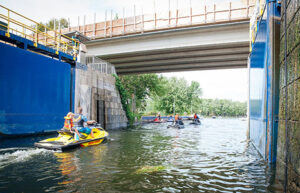Locking Through The Kawarthas on Your PWC 101
Going through your first lock on a personal watercraft (PWC) can be intimidating. All those bigger boats. Huge gates. High concrete walls. Lock masters directing traffic. Sightseers watching from above. And you on your comparatively tiny PWC.
About The Kawartha Locks
A lock exists to raise and lower the water level where terrain changes height. This enables PWC riders to get around a place where the waterway isn’t navigable. Locking through is an art, but fortunately not difficult to master. Learning to lock through properly is also a necessity for PWC exploration of the Kawartha Lakes. That’s because these lakes are interconnected by 18 locks between Hastings and Kirkfield, part of the Trent Severn Waterway. These man-made marvels of engineering include several must-sees, like the canyon-like walls of the huge Burleigh Falls Lock 28, the swing bridge/lock combo through the heart of Bobcaygeon Lock 32 and the world’s highest lift lock at Peterborough Lock 21.
But first, you’ll need a Parks Canada Lock Permit for craft under 12 feet. I recommend buying one in advance to avoid a possibly long wait at a lock station on a weekend. Purchase either online or by driving to your nearest lock station on a weekday. A lock permit is good for any lock operated by Parks Canada (Trent Severn, Rideau Canal and others) and is available for the season, for six days or one day.
Approaching A Lock On Your PWC
When approaching any lock, slow right down to no wake, watch for other boats and check out the lock traffic signal. If the red light is on, moor at the “blue line”, a waiting area designated with a blue strip (while you’re waiting for the gates to open, attach your PWC bumpers). The yellow light means get ready to approach the lock, but stay put. Green means to enter the lock cautiously.
Proceed slowly with no wake and in total control of your PWC. Remember to give recreational boats exiting the lock right of way, and follow any voice instructions or hand signals from lock staff. Staff will direct PWCs to the front or back, left or right side of the lock. Or when it’s crowded, to raft between other recreational boats.
Securing Your PWC Inside A Lock
Once in place, loop (not tie) your mooring rope around the nearest wall cable to secure your PWC so it will move up or down with the water level. Or get a secure grip (preferably by mooring rope and hand) on the boat you’re rafting beside. In either case, also sit sideways to help brace your PWC with your feet to help stop drifting. Be prepared to hang on tightly, because some locks create a strong current that can rock your PWC as water rushes in and out to change the level. Once in place and secure, turn off your PWC and keep it off until the signal comes to exit.
Exiting A Lock On Your PWC
When it’s your turn to do so, retie your mooring rope securely to your PWC so it doesn’t get sucked into the PWC impellor, then steer slowly through the open gates. Maintain no wake speed until you are well beyond the blueline on that side of the lock. And don’t forget a quick “thank you” wave to the lock staff and remove your bumpers!
My Two Final Tips
When planning your PWC ride, check the lock operating hours to ensure you can make the last lock-through of the day before it closes. While every lock in the system keeps the same hours, operating hours varying slightly between weekdays and weekends, and also from early summer to mid-summer, and after Labour Day.
My second tip is that “practise makes perfect”, so get ready for locking thru by becoming proficient at docking your PWC – the same manoeuvres will help you in a lock!
Story by Craig Nicholson, The Intrepid Cottager
Photos by Allan Glanfield
Want to learn more? Find everything you need to know about PWC touring at intrepidcottager.com.
For Trent Severn information, visit https://www.pc.gc.ca/en/lhn-nhs/on/trentsevern/visit/posteeclusage-lockstation




